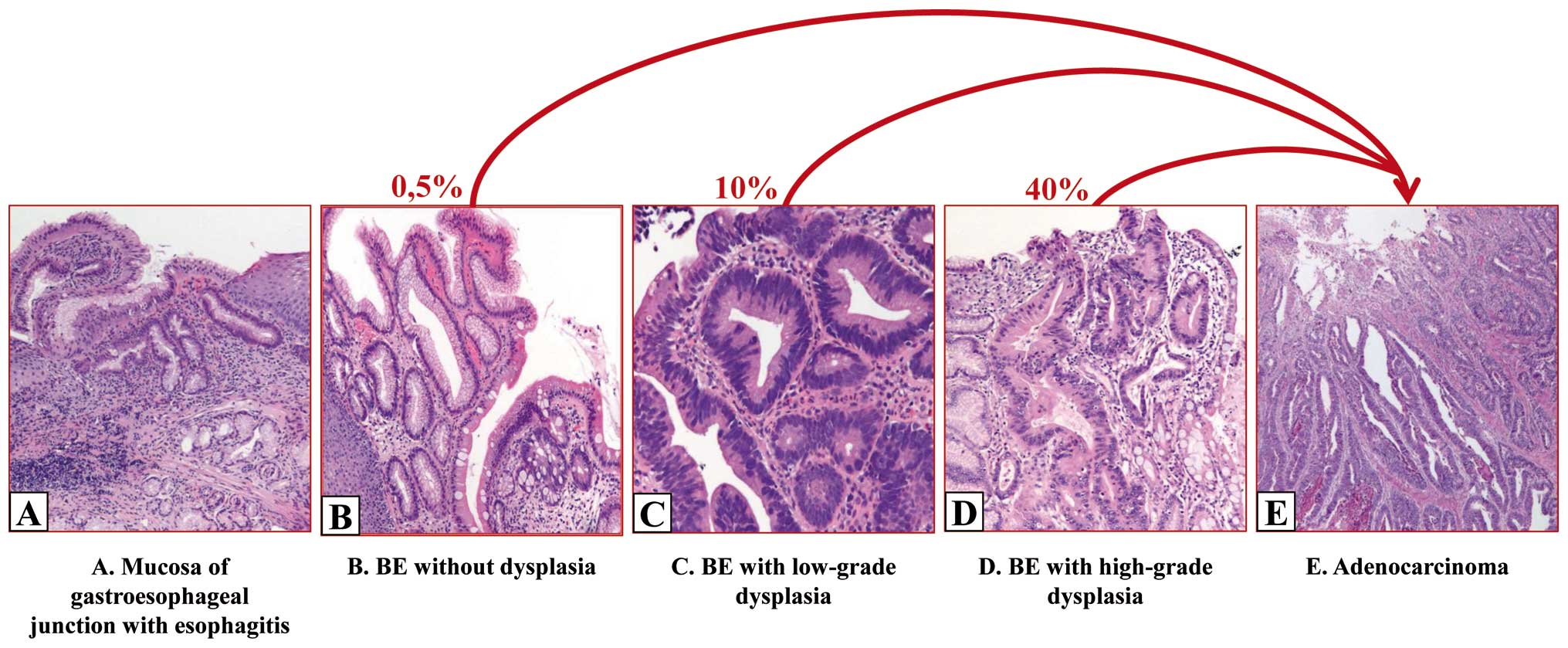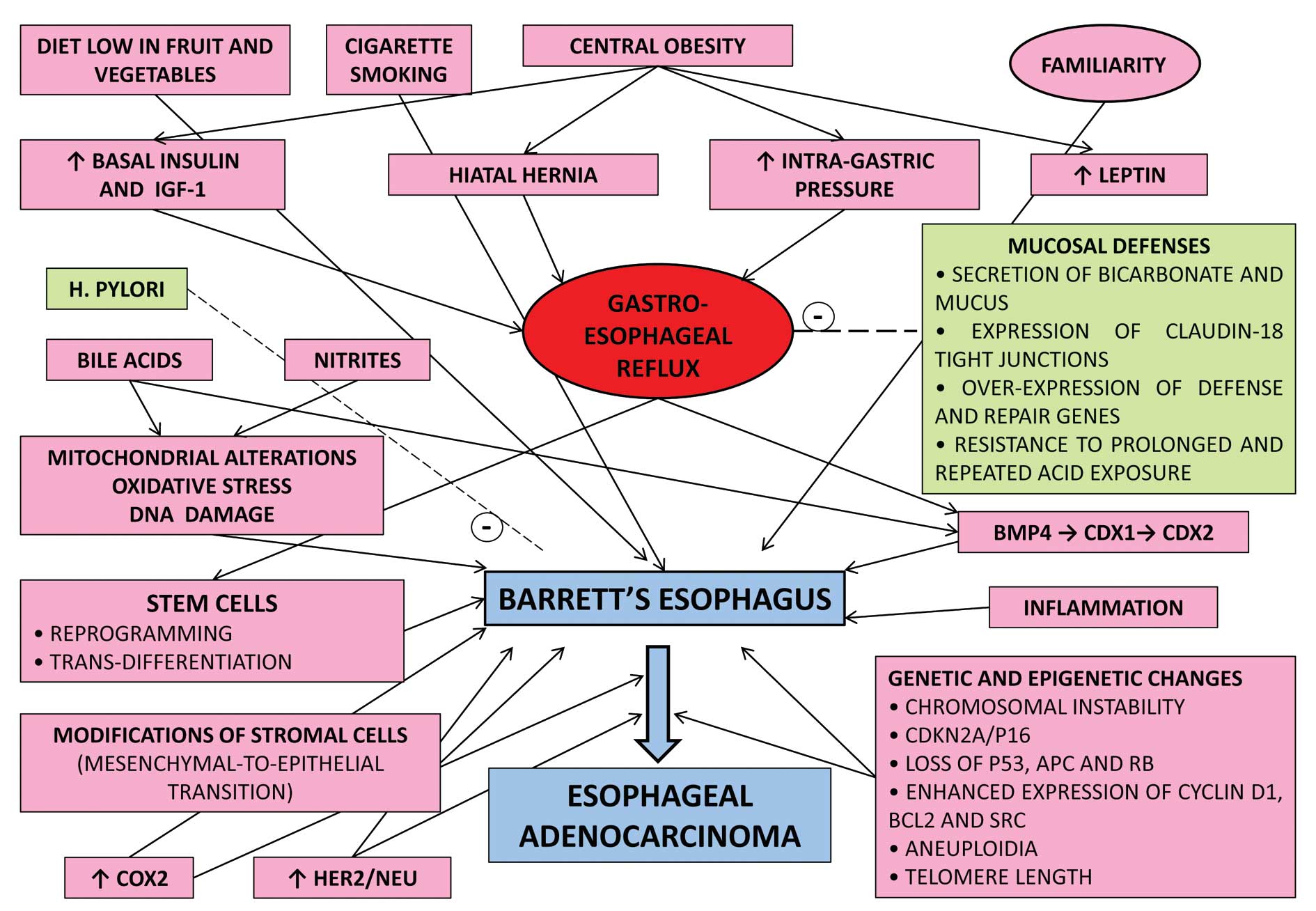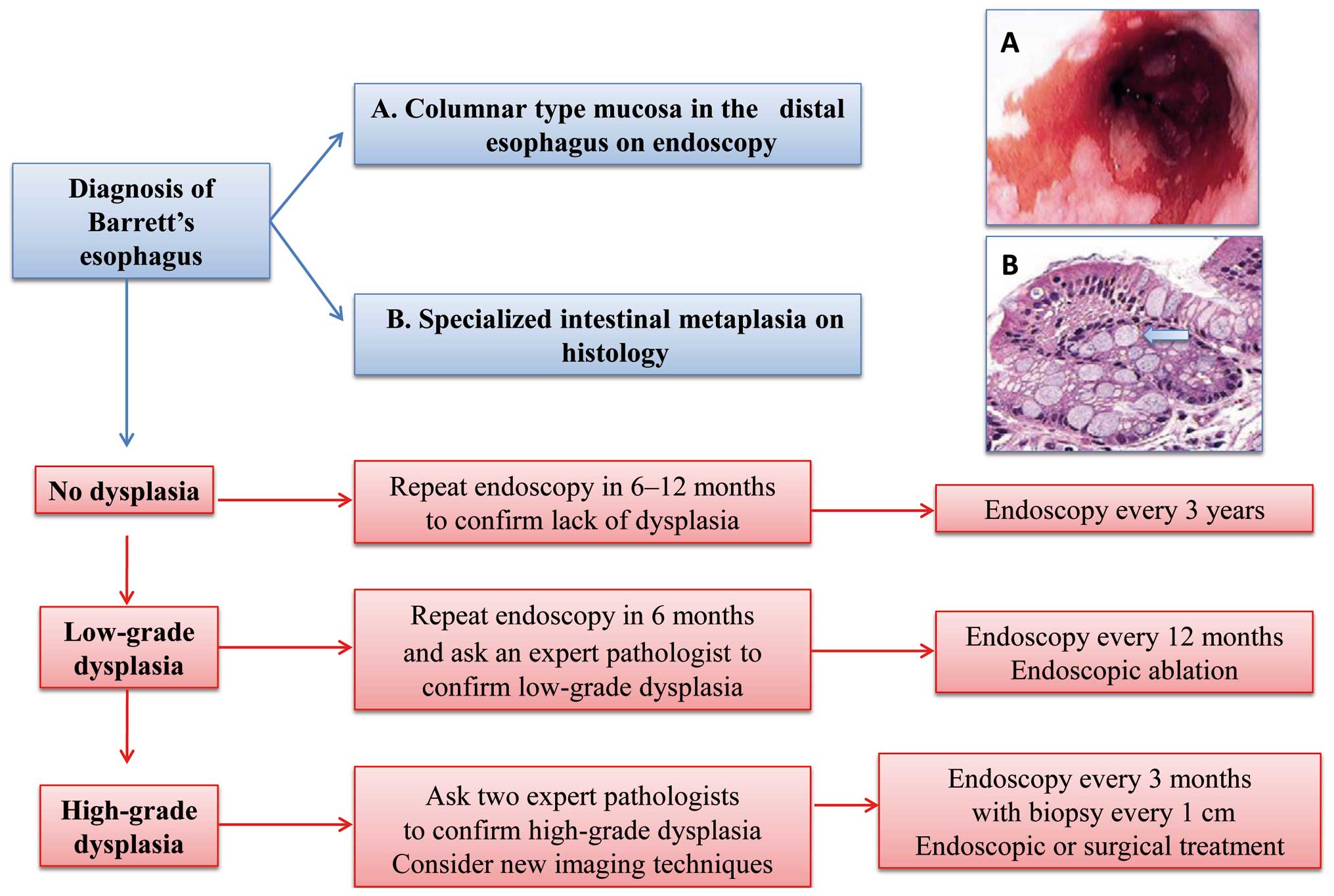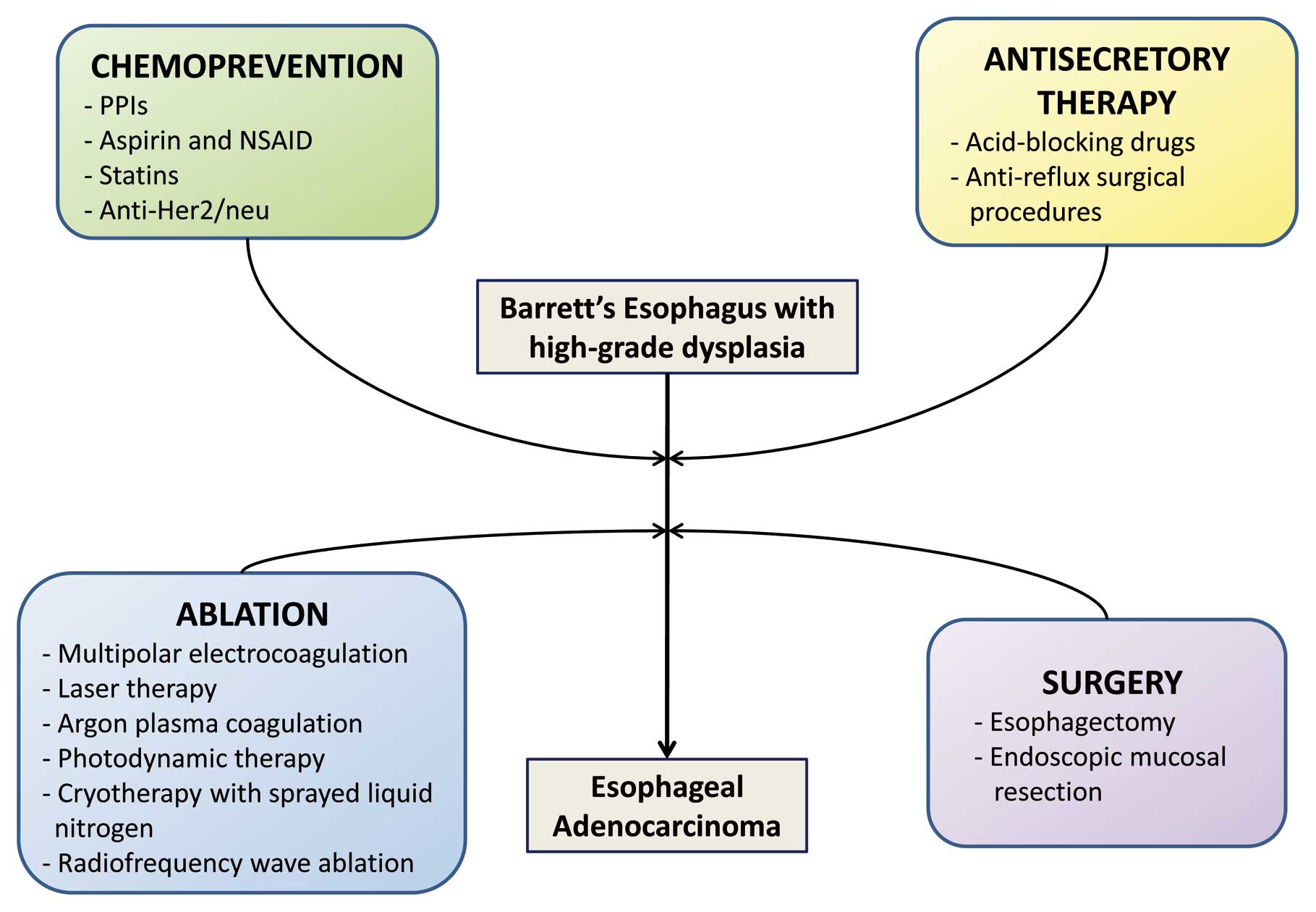Barrett's esophagus and esophageal cancer: An overview
- Authors:
- Vincenza Conteduca
- Domenico Sansonno
- Giuseppe Ingravallo
- Stefania Marangi
- Sabino Russi
- Gianfranco Lauletta
- Franco Dammacco
-
Affiliations: Department of Internal Medicine and Clinical Oncology, University of Bari Medical School, Bari, Italy, Department of Pathology, University of Bari Medical School, Bari, Italy, Digestive Endoscopy Unit, Department of Oncology, John Paul II Center for High Technology Research and Education in Biomedical Sciences, Campobasso, Italy - Published online on: May 17, 2012 https://doi.org/10.3892/ijo.2012.1481
- Pages: 414-424
This article is mentioned in:
Abstract
 |
 |
 |
 |
 |
|
Enzinger P and Mayer R: Esophageal cancer. N Engl J Med. 349:2241–2252. 2003. View Article : Google Scholar : PubMed/NCBI | |
|
Ajani JA, Barthel JS, Bentrem DJ, et al: Esophageal and esophago-gastric junction cancers. J Natl Compr Canc Netw. 9:830–887. 2011.PubMed/NCBI | |
|
Jemal A, Bray F, Center MM, Ferlay J, Ward E and Forman D: Global cancer statistics. CA Cancer J Clin. 61:69–90. 2011. View Article : Google Scholar | |
|
Parkin DM: International variation. Oncogene. 23:6329–6340. 2004. View Article : Google Scholar | |
|
Pohl H and Welch HG: The role of overdiagnosis and reclassification in the marked increase of esophageal adenocarcinoma incidence. J Natl Cancer Inst. 97:142–146. 2005. View Article : Google Scholar : PubMed/NCBI | |
|
Sharma P: Clinical practice. Barrett’s esophagus. N Engl J Med. 361:2548–2556. 2009. | |
|
Ronkainen J, Aro P, Storskrubb T, et al: Prevalence of Barrett’s esophagus in the general population: an endoscopic study. Gastroenterology. 129:1825–1831. 2005. | |
|
Zou D, He J, Ma X, et al: Helicobacter pylori infection and gastritis: the systematic investigation of gastrointestinal diseases in China (SILC). J Gastroenterol Hepatol. 26:908–915. 2011. View Article : Google Scholar | |
|
Bhat S, Coleman HG, Yousef F, Johnston BT, McManus DT, Gavin AT and Murray LJ: Risk of malignant progression in Barrett’s esophagus patients: results from a large population-based study. J Natl Cancer Inst. 103:1049–1057. 2011. | |
|
Hvid-Jensen F, Pedersen L, Drewes AM, Sørensen HT and Funch-Jensen P: Incidence of adenocarcinoma among patients with Barrett’s esophagus. N Engl J Med. 365:1375–1383. 2011. | |
|
Shaheen NJ and Richter JE: Barrett’s esophagus. Lancet. 373:850–861. 2009. | |
|
Kahrilas PJ: The problems with surveillance of Barrett’s esophagus. N Engl J Med. 365:1437–1438. 2011. | |
|
Garud SS, Keilin S, Cai Q and Willingham FF: Diagnosis and management of Barrett’s esophagus for the endoscopist. Ther Adv Gastroenterol. 3:227–238. 2010. | |
|
Dent J, El-Serag HB, Wallander MA and Johansson S: Epidemiology of gastro-oesophageal reflux disease: a systematic review. Gut. 54:710–717. 2005. View Article : Google Scholar : PubMed/NCBI | |
|
Whiteman DC, Parmar P, Fahey P, et al: Association of Helicobacter pylori infection with reduced risk for esophageal cancer is independent of environmental and genetic modifiers. Gastroenterol. 139:73–83. 2010. | |
|
Barrett NR: Chronic peptic ulcer of the oesophagus and ‘oesophagitis’. Br J Surg. 38:175–182. 1950. | |
|
Allison PR and Johnstone AS: The oesophagus lined with gastric mucous membrane. Thorax. 8:87–101. 1953. View Article : Google Scholar : PubMed/NCBI | |
|
Naef AP, Savary M and Ozzello L: Columnar-lined lower esophagus: an acquired lesion with malignant predisposition. Report on 140 cases of Barrett’s esophagus with 12 adenocarcinomas. J Thorac Cardiovasc Surg. 70:826–835. 1975.PubMed/NCBI | |
|
Hamilton SR and Aaltonen LA; World Health Organization of Tumours Classification: Pathology and Genetics of Tumours of the Digestive System. IARC Press; Lyon: 2000 | |
|
Schlemper RJ, Riddell RH, Kato Y, et al: The Vienna classification of gastrointestinal epithelial neoplasia. Gut. 47:251–255. 2000. View Article : Google Scholar : PubMed/NCBI | |
|
Lagergren J: Influence of obesity on the risk of esophageal disorders. Nat Rev Gastroenterol Hepatol. 8:340–347. 2011. View Article : Google Scholar : PubMed/NCBI | |
|
McElholm AR, McKnight AJ, Patterson CC, Johnston BT, Hardie LJ and Murray LJ: A population-based study of IGF axis polymorphisms and the esophageal inflammation, metaplasia, adenocarcinoma sequence. Gastroenterology. 139:204–212. 2010. View Article : Google Scholar : PubMed/NCBI | |
|
Kendall BJ, Macdonald GA, Hayward NK, et al: Leptin and the risk of Barrett’s oesophagus. Gut. 57:448–454. 2008. | |
|
Rubenstein JH, Kao JY, Madanick RD, et al: Association of adiponectin multimers with Barrett’s oesophagus. Gut. 58:1583–1589. 2009.PubMed/NCBI | |
|
Fletcher J, Wirz A, Henry E and McKoll KE: Studies of acid exposure immediately above the gastro-oesophageal squamocolumnar junction: evidence of short segment reflux. Gut. 53:168–173. 2004. View Article : Google Scholar | |
|
Farrè R, De Vos R, Geboes K, et al: Critical role of stress in increased oesophageal mucosa permeability and dilated inter-cellular spaces. Gut. 56:1191–1197. 2007.PubMed/NCBI | |
|
Jovov B, Van Itallie CM, Shaheen NJ, Carson JL, Gambling TM, Anderson JM and Orlando RC: Claudin-18: a dominant tight junction protein in Barrett’s esophagus and likely contributor to its acid resistance. Am J Physiol Gastrointest Liver Physiol. 293:1106–1113. 2007.PubMed/NCBI | |
|
Clemons NJ, McColl KE and Fitzgerald RC: Nitric oxide and acid induce double-strand DNA breaks in Barrett’s esophagus carcinogenesis via distinct mechanisms. Gastroenterology. 133:1198–1209. 2007. | |
|
Dvorak K, Payne CM, Chavarria M, et al: Bile acids in combination with low pH induce oxidative stress and oxidative DNA damage: relevance to the pathogenesis of Barrett’s oesophagus. Gut. 56:763–771. 2007.PubMed/NCBI | |
|
Sun X, Elston R, Barnholtz-Sloan J, et al: A segregation analysis of Barrett’s esophagus and associated adenocarcinomas. Cancer Epidemiol Biomarkers Prev. 19:666–674. 2010. | |
|
Chak A, Ochs-Balcom H, Falk G, et al: Familiality in Barrett’s esophagus, adenocarcinoma of the esophagus, and adenocarcinoma of the gastroesophageal junction. Cancer Epidemiol Biomarkers Prev. 15:1668–1673. 2006. | |
|
Croagh D, Phillips WA, Redvers R, Thomas RJ and Kaur P: Identification of candidate murine esophageal stem cells using a combination of cell kinetic studies and cell surface markers. Stem Cells. 25:313–318. 2007. View Article : Google Scholar : PubMed/NCBI | |
|
Croagh D, Thomas RJ, Phillips WA and Kaur P: Esophageal stem cells - a review of their identification and characterization. Stem Cell Rev. 4:261–268. 2008. View Article : Google Scholar : PubMed/NCBI | |
|
Leedham SJ, Preston SL, McDonald SA, et al: Individual crypt genetic heterogeneity and the origin of metaplastic glandular epithelium in human Barrett’s oesophagus. Gut. 57:1041–1408. 2008.PubMed/NCBI | |
|
Sarosi G, Brown G, Jaiswal K, et al: Bone marrow progenitor cells contribute to esophageal regeneration and metaplasia in a rat model of Barrett’s esophagus. Dis Esophagus. 21:43–50. 2008.PubMed/NCBI | |
|
Yu WY, Slack JM and Tosh D: Conversion of columnar to stratified squamous epithelium in the developing mouse oesophagus. Dev Biol. 284:157–170. 2005. View Article : Google Scholar : PubMed/NCBI | |
|
Kong J, Crissey MA, Funakoshi S, Kreindler JL and Lynch JP: Ectopic Cdx2 expression in murine esophagus models an intermediate stage in the emergence of Barrett’s esophagus. PloS One. 6:e182802011.PubMed/NCBI | |
|
Kosinski C, Stange DE, Xu C, et al: Indian hedgehog regulates intestinal stem cell fate through epithelial-mesenchymal interactions during development. Gastroenterology. 139:893–903. 2010. View Article : Google Scholar | |
|
Kazumori H, Ishihara S and Kinoshita Y: Roles of caudal-related homeobox gene Cdx1 in oesophageal epithelial cells in Barrett’s epithelium development. Gut. 58:620–628. 2009. | |
|
Phillips WA, Lord RV, Nancarrow DJ, Watson DJ and Whiteman DC: Barrett’s esophagus. J Gastroenterol Hepatol. 26:639–648. 2011. | |
|
Colleypriest BJ, Farrant JM, Slack JM and Tosh D: The role of Cdx2 in Barrett’s metaplasia. Biochem Soc Trans. 38:364–369. 2010. | |
|
Mutoh H, Sakurai S, Satoh K, Osaka H, Hakamata Y, Takeuchi T and Sugano K: Cdx1 induced intestinal metaplasia in the transgenic mouse stomach: comparative study with Cdx2 transgenic mice. Gut. 53:1416–1423. 2010. View Article : Google Scholar : PubMed/NCBI | |
|
Barros R, da Costa LT, Pinto-de-Sousa J, Duluc I, Freund JN, David L and Almeida R: CDX2 autoregulation in human intestinal metaplasia of the stomach: impact on the stability of the phenotype. Gut. 60:290–298. 2011. View Article : Google Scholar : PubMed/NCBI | |
|
Huo X, Zhang HY, Zhang XI, et al: Acid and bile salt-induced CDX2 expression differs in esophageal squamous cells from patients with and without Barrett’s esophagus. Gastroenterology. 139:194–203. 2010.PubMed/NCBI | |
|
Chen X, Qin R, Liu B, Ma Y, et al: Multilayered epithelium in a rat model and human Barrett’s esophagus: similar expression patterns of transcription factors and differentiation markers. BMC Gastroenterol. 8:1–9. 2008.PubMed/NCBI | |
|
Badreddine RJ and Wang KK: Barrett esophagus: an update. Nat Rev Gastroenterol Hepatol. 7:369–378. 2010. View Article : Google Scholar | |
|
Wang DH, Clemons NJ, Miyashita T, et al: Aberrant epithelialmesenchymal Hedgehog signaling characterizes Barrett’s metaplasia. Gastroenterology. 138:1810–1822. 2010.PubMed/NCBI | |
|
Liu W, Hahn H, Odze RD and Goyal RK: Metaplastic esophageal columnar epithelium without goblet cells shows DNA content abnormalities similar to goblet cell-containing epithelium. Am J Gastroenterol. 104:816–824. 2009. View Article : Google Scholar | |
|
Chaves P, Crespo M, Ribeiro C, et al: Chromosomal analysis of Barrett’s cells: demonstration of instability and detection of the metaplastic lineage involved. Mod Pathol. 20:788–796. 2007. | |
|
Li X, Galipeau PC, Sanchez CA, et al: Single nucleotide polymorphism-based genome-wide chromosome copy change, loss of heterozygosity, and aneuploidy in Barrett’s esophagus neoplastic progression. Cancer Prev Res. 1:413–423. 2008.PubMed/NCBI | |
|
Wu IC, Zhao Y, Zhai R, et al: Association between polymorphisms in cancer-related genes and early onset of esophageal adenocarcinoma. Neoplasia. 13:386–392. 2011.PubMed/NCBI | |
|
Galipeau PC, Li X, Blount PL, et al: NSAIDs modulate CDKN2A, TP53, and DNA content risk for progression to esophageal adenocarcinoma. PLoS Med. 4:e672007. View Article : Google Scholar : PubMed/NCBI | |
|
Xing J, Ajani JA, Chen M, et al: Constitutive short telomere length of chromosome 17p and 12q but not 11q and 2p is associated with an increased risk for esophageal cancer. Cancer Prev Res. 2:459–465. 2009. View Article : Google Scholar : PubMed/NCBI | |
|
Wang C, Yuan Y and Hunt RH: Helicobacter pylori infection and Barrett’s esophagus: a systematic review and meta-analysis. Am J Gastroenterol. 104:492–500. 2009. View Article : Google Scholar | |
|
Anderson LA, Johnston BT, Watson RG, et al: Nonsteroidal anti-inflammatory drugs and the esophageal inflammation-metaplasia-adenocarcinoma sequence. Cancer Res. 66:4975–4982. 2006. View Article : Google Scholar : PubMed/NCBI | |
|
Kubo A, Block G, Quesenberry CP, Buffler P and Corley DA: Effects of dietary fiber, fats, and meat intakes on the risk of Barrett’s esophagus. Nutr Cancer. 61:607–616. 2009.PubMed/NCBI | |
|
Kubo A, Levin TR, Block G, et al: Dietary antioxidants, fruits, and vegetables and the risk of Barrett’s esophagus. Am J Gastroenterol. 103:1614–1623. 2008. | |
|
Rossi E, Grisanti S, Villanacci V, et al: HER-2 overexpression/amplification in Barrett’s oesophagus predicts early transition from dysplasia to adenocarcinoma: a clinico-pathologic study. J Cell Mol Med. 13:3826–3833. 2009. | |
|
Vakil N, van Zanten SV, Kahrilas P, Dent J and Jones R: The Montreal definition and classification of gastroesophageal reflux disease: a global evidence-based consensus. Am J Gastroenterol. 101:1900–1920. 2006. View Article : Google Scholar : PubMed/NCBI | |
|
Lundell LR, Dent J, Bennett JR, et al: Endoscopic assessment of oesophagitis: clinical and functional correlates and further validation of the Los Angeles classification. Gut. 45:172–180. 1999. View Article : Google Scholar : PubMed/NCBI | |
|
American Gastroenterological Association; Spechler SJ, Sharma P, Souza RF, Inadomi JM and Shaheen NJ: American Gastroenterological Association medical position statement on the man agement of Barrett’s esophagus. Gastroenterology. 140:1084–1091. 2011. | |
|
Voltaggio L, Montgomery EA and Lam-Himlin D: A clinical and histopathologic focus on Barrett esophagus and Barrett-related dysplasia. Arch Pathol Lab Med. 135:1249–1260. 2011. View Article : Google Scholar : PubMed/NCBI | |
|
Wang KK and Sampliner RE; Practice Parameters Committee of the American College of Gastroenterology: Updated guidelines 2008 for the diagnosis, surveillance and therapy of Barrett’s esophagus. Am J Gastroenterol. 103:788–797. 2008.PubMed/NCBI | |
|
Playford RJ: New British Society of Gastroenterology (BSG) guidelines for the diagnosis and management of Barrett’s oesophagus. Gut. 55:4422006.PubMed/NCBI | |
|
Sikkema M, Looman CWN, Steyerberg EW, et al: Predictors for neoplastic progression in patients with Barrett’s esophagus: a prospective cohort study. Am J Gastroenterol. 106:1231–1238. 2011. | |
|
Sharma P, Dent J, Armstrong D, et al: The development and validation of an endoscopic grading system for Barrett’s esophagus: the Prague C & M Criteria. Gastroenterology. 131:1392–1399. 2006.PubMed/NCBI | |
|
Wani S, Mathur S and Sharma P: How to manage a Barrett’s esophagus patient with low-grade dysplasia. Clin Gastroenterol Hepatol. 7:27–32. 2009. | |
|
Mannath J, Subramanian V, Hawkey CJ and Raqunath K: Narrow band imaging for characterization of high grade dysplasia and specialized intestinal metaplasia in Barrett’s esophagus: a meta-analysis. Endoscopy. 42:351–359. 2010. | |
|
Wasielica-Berger J, Baniukiewicz A, Wroblewski E, Chwiesko A and Dabrowski A: Magnification endoscopy and chromoendoscopy in evaluation of specialized intestinal metaplasia in Barrett’s esophagus. Dig Dis Sci. 56:1987–1995. 2011. | |
|
Prasad GA, Wu TT, Wigle DA, et al: Endoscopic and surgical treatment of mucosal (T1a) esophageal adenocarcinoma in Barrett’s esophagus. Gastroenterology. 137:815–823. 2009. | |
|
Yachimski P, Nishioka NS, Richards E and Hur C: Treatment of Barrett’s esophagus with high-grade dysplasia or cancer: predictor of surgical versus endoscopic therapy. Clin Gastroenterol Hepatol. 6:1206–1211. 2008. | |
|
Fleischer DE, Overholt BF, Sharma P, et al: Endoscopic ablation of Barrett’s esophagus: a multicenter study with 2.5-year follow-up. Gastrointest Endosc. 68:867–876. 2008. | |
|
Pech O, Behrens A, May A, et al: Long-term results and risk factor analysis for recurrence after curative endoscopic therapy in 349 patients with high-grade intraepithelial neoplasia and mucosal adenocarcinoma in Barrett’s oesophagus. Gut. 57:1200–1206. 2008.PubMed/NCBI | |
|
Gaddam S and Sharma P: Advances in endoscopic diagnosis and treatment of Barrett’s esophagus. J Dig Dis. 11:323–333. 2010. | |
|
Nealis TB, Washington K and Keswani RN: Endoscopic therapy of esophageal premalignancy and early malignancy. J Natl Compr Cancer Netw. 9:890–899. 2011.PubMed/NCBI | |
|
Yachimski P, Puricelli WP and Nishioka NS: Patient predictors of esophageal stricture development after photodynamic therapy. Clin Gastroenterol Hepatol. 6:302–308. 2008. View Article : Google Scholar : PubMed/NCBI | |
|
Ulsiewicz WJ and Shaheen NJ: The role of radiofrequency ablation in the management of Barrett’s esophagus. Gastrointest Endosc Clin N Am. 21:95–109. 2011. | |
|
Shaheen NJ, Overholt BF, Sampliner RE, et al: Durability of radiofrequency ablation in Barrett’s esophagus with dysplasia. Gastroenterology. 141:460–468. 2011. | |
|
Shaheen NJ, Sharma P, Overholt BF, et al: Radiofrequency ablation in Barrett’s esophagus with dysplasia. N Engl J Med. 360:2277–2288. 2009. | |
|
Dent J: Barrett’s esophagus: A historical perspective, an update on core practicalities and predictions on future evolutions of management. J Gastroenterol Hepatol. 26:11–30. 2011. | |
|
El-Serag HB, Aguirre TV, Davis S, Kuebeler M, Bhattacharyya A and Sampliner RE: Proton pump inhibitors are associated with reduced incidence of dysplasia in Barrett’s esophagus. Am J Gastroenterol. 99:1877–1883. 2004. | |
|
Nguyen DM, El-Serag HB, Henderson L, Stein D, Bhattacharyya A and Sampliner RE: Medication usage and the risk of neoplasia in patients with Barrett’s esophagus. Clin Gastroenterol Hepatol. 7:1299–1304. 2009.PubMed/NCBI | |
|
Jankowski JA and Hooper PA: Chemoprevention in Barrett’s esophagus: A pill a day? Gastrointest Endosc Clin N Am. 21:155–170. 2011. | |
|
Neumann H, Mönkemüller K, Vieth M and Malfertheiner P: Chemoprevention of adenocarcinoma associated with Barrett’s esophagus: potential options. Dig Dis. 27:18–23. 2009. | |
|
Heath EI, Canto MI, Piantadosi S, et al: Secondary chemo-prevention of Barrett’s esophagus with celecoxib: results of a randomized trial. J Natl Cancer Inst. 99:545–557. 2007. | |
|
Das D, Chilton AP and Jankowski JA: Chemoprevention of oesophageal cancer and the AspECT trial. Recent Results Cancer Res. 181:161–169. 2009. View Article : Google Scholar : PubMed/NCBI | |
|
Ong CA, Lao-Sirieix P and Fitzgerald RC: Biomarkers in Barrett’s esophagus and esophageal adenocarcinoma: Predictors of progression and prognosis. World J Gastroenterol. 16:5669–5681. 2010. |










